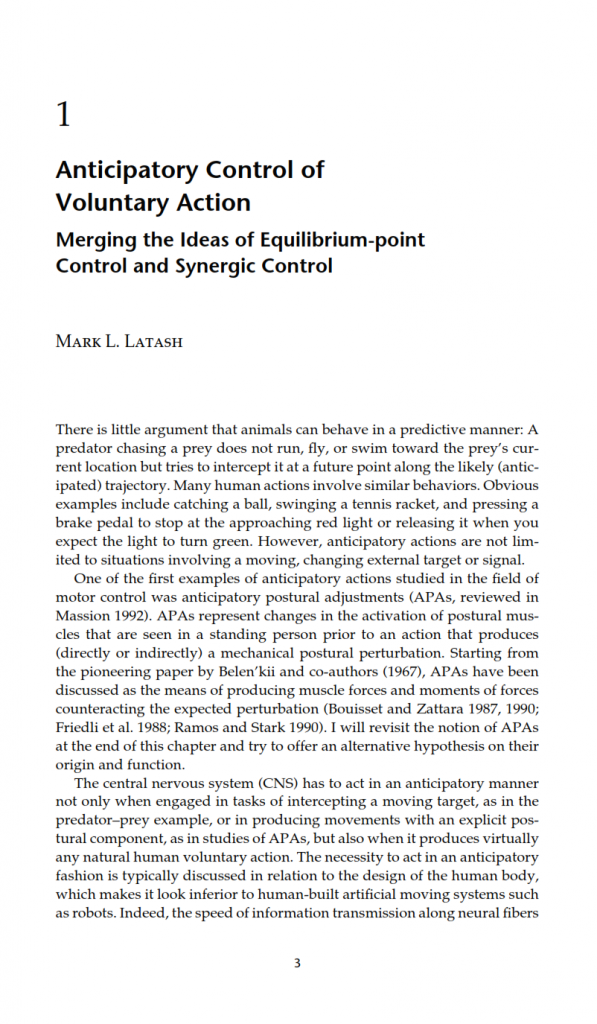عنوان انگلیسی:
Anticipatory Control of Voluntary Action
Merging the Ideas of Equilibrium-point Control and Synergic Control
این مطلب فصل۱ از کتاب کنترل حرکتی : نظریه ها، تجارب و کاربردها ست که میتوانید دانلودکامل کتاب را که قبلا معرفی کردیم از اینجا دانلود کنید همچنین فصل ۱۳ کتاب را هم تحت عنوان پیش بینی پیامدهای بلندمدت حرکات با استفاده دستی و حرکات با استفاده از ابزارمی تونید از اینجا دانلود کنید.
نویسنده:
Mark L. Latash
There is little argument that animals can behave in a predictive manner: A predator chasing a prey does not run, fly, or swim toward the prey’s current location but tries to intercept it at a future point along the likely (anticipated) trajectory.
Many human actions involve similar behaviors. Obvious examples include catching a ball, swinging a tennis racket, and pressing a brake pedal to stop at the approaching red light or releasing it when you expect the light to turn green.
However, anticipatory actions are not limited to situations involving a moving, changing external target or signal. One of the first examples of anticipatory actions studied in the field of motor control was anticipatory postural adjustments (APAs, reviewed in Massion 1992 ).
APAs represent changes in the activation of postural muscles that are seen in a standing person prior to an action that produces (directly or indirectly) a mechanical postural perturbation.
Starting from the pioneering paper by Belen’kii and co-authors ( 1967 ), APAs have been discussed as the means of producing muscle forces and moments of forces counteracting the expected perturbation (Bouisset and Zattara 1987 , 1990; Friedli et al. 1988; Ramos and Stark 1990 ).
I will revisit the notion of APAs at the end of this chapter and try to offer an alternative hypothesis on their origin and function. The central nervous system (CNS) has to act in an anticipatory manner not only when engaged in tasks of intercepting a moving target, as in the predator-prey example, or in producing movements with an explicit postural component, as in studies of APAs, but also when it produces virtually any natural human voluntary action.
The necessity to act in an anticipatory fashion is typically discussed in relation to the design of the human body, which makes it look inferior to human-built artificial moving systems such as robots.
Indeed, the speed of information transmission along neural fibers is much lower than along electric wires, and muscles look sluggish when compared to powerful torque motors
عنوان فارسی مقاله:
پیش بینی کنترل اعمال ارادی: ادغام ایده های کنترل نقطه-موازنه و کنترل سینرژی
خلاصه فارسی:
مباحث اندکی درباره اینکه حیوانات قادرند بر طبق یک الگوی پیش بینانه رفتار کنند وجود دارد: یک شکارچی برای تعقیب شکار خود، به سمت مکان فعلی طعمه چه به صورت دویدن ،پرواز کردن یا شنا کردن یورش نمی برد؛ بلکه تلاش می کند حرکت آن را در نقطه ای جلوتر (نقطه ای پیش بینی شده) بر روی خط سیر طعمه قطع کند.
اعمال زیادی در انسان مشابه این گونه رفتارها است. مثال های واضح شامل گرفتن توپ، تاب دادن موزون راکت تنیس و فشردن پدال ترمز هنگام نزدیک شدن به چراغ قرمز و یا رها کردن آن زمانی که شخص پیش بینی میکند چراغ در حال سبز شدن است، می باشد. با این حال اعمال پیش بینانه محدود به وضعیت هایی شامل یک حرکت یا تغییر هدف یا علایم خارجی نمی شود.
یکی از اولین نمونه های اعمال پیش بینانه (مورد انتظار) که در حوزه کنترل حرکتی مورد مطالعه قرار گرفت تعدیلات وضعیتی مورد انتظار (APA ها، بازبینی شده توسط میشن ۱۹۹۲) بود.
APAها نشان دهنده تغییرات در فعالیت وضعیتی عضلات هستند که در یک فرد ایستاده پیش از انجام عملی دیده می شود که (به صورت مستقیم یا غیرمستقیم) باعث ایجاد یک آشفتگی وضعیتی مکانیکی می گردد.
در مقاله پیشگام نوشته شده در این رابطه، بلنکی و دستیاران (۱۹۶۷) APAها را به عنوان تولید کننده ی نیروی عضلانی و گشتاور نیرویی خنثی کننده آشفتگی مورد انتظار، مورد مباحثه قرار دادند (فریدلی ۱۹۸۸؛ بویزیت و زاتارا ۱۹۸۷ و ۱۹۹۰؛ راموس و اشتارک ۱۹۹۰).
مفهوم APAها را در پایان این فصل مورد بازبینی قرار داده و تلاش میکنیم فرضیه جایگزینی را درباره سرمنشا و عملکرد آنها پیشنهاد دهیم.
برای دانلود ترجمه فارسی و دانلود مقاله از طریق زیر اقدم کنید
دانلود صفحه اول
دانلود صفحه اول




